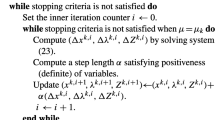Abstract
An important task in designing a truss structure is to determine the initial configuration of the truss. In the absence of an efficient optimization technique, the selection of initial geometry is based on a trial and error procedure or standard truss configurations or past experiences. In this work, a fully automated algorithm is proposed which can be used to predict initial truss geometry from the grayscale images obtained from topology optimization of design domain. It predicts the locations of joints and the connectivity of members. It also estimates the approximate cross-sectional areas of the members. The interpreted truss geometry can be modified or directly used for structural analysis and design. Numerical examples are presented to demonstrate the functioning of the algorithm under various scenarios. The developed algorithm has been implemented as part of a web-based truss design application, previously developed by the same authors.


















Similar content being viewed by others
References
Sigmund O, Petersson J (1998) Numerical instabilities in topology optimization: a survey on procedures dealing with checkerboards, mesh-dependencies and local minima. Struct Optim 16:68–75
Kumar A, Gossard D (1996) Synthesis of optimal shape and topology of structures. J Mech Des 118:68–74
Hsu Y-L, Hsu M-S, Chen C-T (2001) Interpreting results from topology optimization using density contours. Comput Struct 79:1049–1058
Youn S-K, Park S-H (1997) A study on the shape extraction process in the structural topology optimization using homogenized material. Comput Struct 62:527–538
Zimmerman RW (1992) Hashin-shtrikman bounds on the poisson ratio of a composite material. Mech Res Commun 19:563–569
Hsu M-H, Hsu Y-L (2005) Interpreting three-dimensional structural topology optimization results. Comput Struct 83:327–337
Hultman M (2010) Weight optimization of steel trusses by a genetic algorithm. Lund University, Department of Structural Engineering
Eurocode 3: design of steel structures: part 1–5: plated structural elements, BSI, London, 2010. Incorporating corrigendum April 2009
Baldock R, Shea K (2006) Structural topology optimization of braced steel frameworks using genetic programming. In: Intelligent Computing in Engineering and Architecture. Springer, pp 54–61
ANSI B (2005) AISC 360-05-specification for structural steel buildings. Chicago AISC
Kutylowski R, Rasiak B (2009) Local buckling design problem for topology optimized truss girders. PAMM 9:567–568
Barr B (2006) Current and future trends in bridge design. Construction and maintenance. Thomas Telford Ltd, London
Zakhama R, Abdalla M, Gürdal Z, Smaoui H (2007) Wind load effect in topology optimization problems. J Phys Conf Ser 75:012048
Svanberg K (1987) The method of moving asymptotes-a new method for structural optimization. Int J Numer Methods Eng 24:359–373
Liang QQ, Xie YM, Steven GP (2000) Optimal topology design of bracing systems for multistory steel frames. J Struct Eng 126:823–829
Kingman JJ, Tsavdaridis KD, Toropov J (2014) Applications of topology optimization in structural engineering. Jordan J Sci Technol
Sokół T (2011) A 99 line code for discretized michell truss optimization written in mathematica. Struct Multidiscip Optim 43:181–190
Gilbert M, Tyas A (2003) Layout optimization of large scale pin-jointed frames. Eng Comput 20:1044–1064
Martinez P, Marti P, Querin O (2007) Growth method for size, topology, and geometry optimization of truss structures. Struct Multidiscip Optim 33:13–26
BIS (2007) IS 800:2007 General construction in steel: Code of practice
Mandhyan A, Srivastava G, Krishnamoorthi S (2014) Web application for size and topology optimization of trusses and gusset plates. In: International Workshop on Computational Micromechanics of Materials, Madrid, Spain
Sigmund O (2001) A 99 line topology optimization code written in matlab. Struct Multidiscip Optim 21:120–127
Enterprises Scilab (2012) Scilab: Free and Open Source software for numerical computation. Scilab Enterprises, Orsay
Oppenheim AV, Schafer RW, Buck JR (1989) Discrete-time signal processing, vol 2. Prentice-hall, Englewood Cliffs
Zerva A, Zervas V (2002) Spatial variation of seismic ground motions: an overview. Appl Mech Rev 55:271–297
Hemp WS (1973) Optimum structures. Clarendon Press, Oxford
Author information
Authors and Affiliations
Corresponding author
Rights and permissions
About this article
Cite this article
Mandhyan, A., Srivastava, G. & Krishnamoorthi, S. A novel method for prediction of truss geometry from topology optimization. Engineering with Computers 33, 95–106 (2017). https://doi.org/10.1007/s00366-016-0474-x
Received:
Accepted:
Published:
Issue Date:
DOI: https://doi.org/10.1007/s00366-016-0474-x




